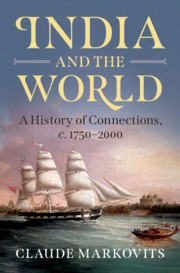Book contents
- India and the World
- India and the World
- Copyright page
- Dedication
- Contents
- Figures
- Tables
- Acknowledgements
- Chronology
- Glossary
- Abbreviations
- Map of India’s Global Connections, 1750–2000
- Introduction
- 1 India in the Global Economy
- 2 India in Global Human Circulations
- 3 India in the World of Wars and Peace
- 4 India in the Global Exchange of Ideas
- 5 India in Global Cultural Circulations
- 6 Indians and Others
- 7 Two Global Indian Events
- Conclusion
- Bibliography
- Index
3 - India in the World of Wars and Peace
Published online by Cambridge University Press: 19 March 2021
- India and the World
- India and the World
- Copyright page
- Dedication
- Contents
- Figures
- Tables
- Acknowledgements
- Chronology
- Glossary
- Abbreviations
- Map of India’s Global Connections, 1750–2000
- Introduction
- 1 India in the Global Economy
- 2 India in Global Human Circulations
- 3 India in the World of Wars and Peace
- 4 India in the Global Exchange of Ideas
- 5 India in Global Cultural Circulations
- 6 Indians and Others
- 7 Two Global Indian Events
- Conclusion
- Bibliography
- Index
Summary
I look at India’s role as a hub of circulation of military personnel. During the second half of the eighteenth century, India was a battlefield between the British, the French and Indian powers, in which soldiers of various provenance were mobilised, but most important was the rise of the sepoy armies of the East India Company. Apart from contributing to the establishment of British preponderance in India, the sepoys were also used in expeditions abroad, starting with their participation in an assault against Spanish Manila in 1762. Eschewing an exclusive focus on the military aspect, I scrutinise the archive of sepoy deployments outside India for information about how ‘ordinary’ Indians dealt with foreign lands and foreign people. I pay particular attention to the role of Indian soldiers in the two world wars. I present a case study based on the censored mail of the Indian expeditionary force soldiers sent to France in 1914–15, a rich trove of observations sometimes bordering on ethnographic reportage. After independence, India’s armies continued to play a global role as the largest manpower contributor to UN peacekeeping. I also look at India’s contribution to world peace.
- Type
- Chapter
- Information
- India and the WorldA History of Connections, c. 1750–2000, pp. 86 - 116Publisher: Cambridge University PressPrint publication year: 2021

